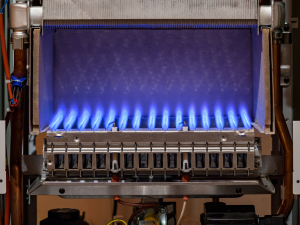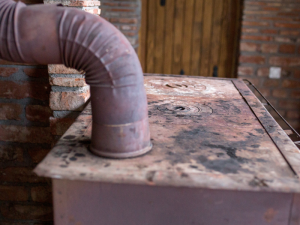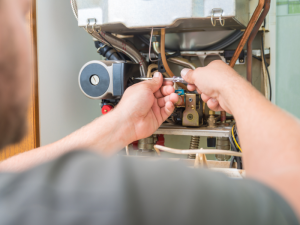Did you know that dirty burners can prevent your furnace from working optimally? Cleaning the gas furnace burners is a vital maintenance step. And you will be surprised to know that you can do it yourself.
Ideally, gas furnaces should be cleaned at the onset of every cold season. While gas furnace burners cleaning is part of a professional furnace tune-up, you might not have the time to schedule an HVAC technician to clean them, or you might want to save on HVAC maintenance bills.
If you have been researching how to clean gas furnace burners, keep reading as we provide a comprehensive gas furnace cleaning guide.
What is a gas furnace burner?
This is a component of a furnace where air mixes with gas, is burned, and subsequently heats the house. Depending on the type of furnace, the gas and air can mix directly in the furnace or be mixed before in a pre-mixer.
How do furnace burners work?
As we mentioned, furnace burners work by taking the air and gas mixture, burning it, and distributing it in the home. However, this involves various steps.
The heating process is initiated by the thermostat. The gas valve then opens and delivers gas to the burners. Air is brought in from the exterior of the home to mix with the gas. To initiate the gas and air mixture, the pilot light engages. The heated air is then passed through the heat exchanger, and the heat is transferred via the ductwork. This warmed air is then distributed throughout the home by the blower fan.
How to know when to clean gas furnace burners
You can know when to clean gas furnace burners using the blue flame test.
To do this test, start by taking the furnace cover off, turning on the thermostat, and watching the flames. All flames in the burners should be the same size.
Also, the flames should burn with a steady bluish color. If you notice streaks of yellow, green, or orange, it could be a sign of incomplete combustion that can be caused by other issues. If you notice that one flame is smaller than others, cleaning the gas furnace burners is vital. If all the flames are of the same size, check other parts of the burner that require cleaning and maintenance.
How to clean gas furnace burners
To clean your gas furnace burner, you will need:
- A power drill/ a small wrench- You will use this to access the burners since they are held in a screwed burner box.
- Brass brush- This will be used to remove debris from the burner.
- Flexible drill extension- This will help you reach screws that are located in hard-to-reach areas.
- A bottle of compressed air- The compressed air will remove debris or dust from the burner.
1. Start by turning off power to the furnace
Before you start the gas furnace burner cleaning process, turn off all power that leads to the furnace. You can either turn the power off from the breaker or the furnace power switch.
2. Remove furnace access panel/doors
Different furnaces have varying door designs. While some slide off, others are spring-loaded. If you are unsure how to remove the furnace doors, you can check the manual.
3. Locate the burners and open the burner box
Some burners may be hidden within the metal casing, while others may be housed in a burner box. Once you locate the burners, carefully examine how they are placed. Taking a picture will eliminate placement issues when putting the burner back. Using the small wrench or power drill, remove the screws that are holding the burner.
4. Remove the burner from the furnace
Burners resemble automobile exhaust pipes. If your burner is not held by a metal sheet, this process is quite easy. You need to be gentle when removing the first burner. Check for markings that distinguish the bottom from the top. If the markings are not available, place each set the same way it was placed to avoid confusion when putting it back.
5. Clean the burners
Use a small wire brush to remove build-up on each burner. Blow the compressed air through each end. This will dislodge carbon deposits that are inside the burner. Ensure to brush the burner again until there are no signs of carbon deposits. Also, blow debris out of the fins on both sides of the burner.
6. Clean the flame sensor
Often ignored, this is a small rod that is mounted behind the last burner. It has a porcelain base. When it gets coated with carbon, the flame sensor is unable to detect a flame. Use fine steel wool to clean the sensor rod until it’s shiny.
7. Replace the burner and retainer
Start with the farthest burner from the gas valve. Replace the burners in turn until the tabs engage. Take care not to force any burner into place since you may risk breaking the components.
8. Once you clean the gas furnace burner, carry out the blue test again
If the flames are still inconsistent, call in an HVAC expert for a professional inspection.
What are the common problems that are prevalent with gas furnace burners?
Rust– This problem is common with furnace burners that have poor air circulation and experience moisture build-up as a result.
It commonly occurs in poorly maintained furnaces, causing small bits of rust to form on the metal surfaces or the burners. When these flake off, they land on the burners and can damage the furnace. If you notice rust on your furnace burner, schedule a gas furnace burner cleaning or a replacement based on the severity of the damage.
Cracks– If the furnace burner is old, you may notice cracks. This takes place due to metal fatigue that occurs with the constant expansion and contraction in the heating and cooling process. Most cracked furnace burners necessitate replacements.
Insufficient heat– A furnace burner that produces insufficient heat may need to be adjusted.
Clogs– If you rarely schedule burner maintenance, you are likely to experience clogs in your furnace burner. When clogged, the burner will not light correctly. You may also notice increased noise coming from the burner.
How can homeowners maintain gas furnace burners for optimal performance?
Maintaining gas furnace burners is not complicated. Yet, simple steps such as cleaning gas furnace burners ensure that your system works optimally and prevents regular breakdowns. Regular maintenance with an HVAC expert will also ensure that any issues are addressed before they become troublesome.




